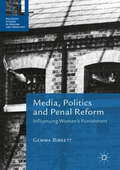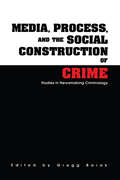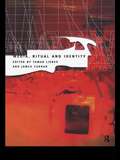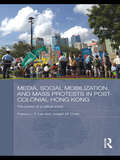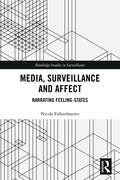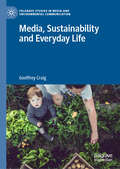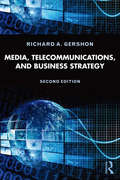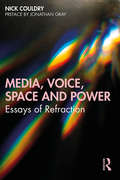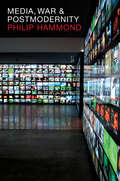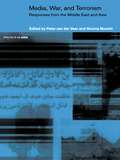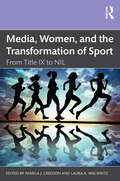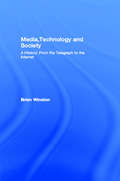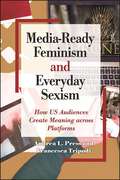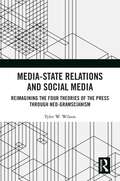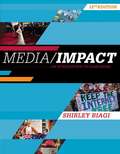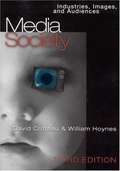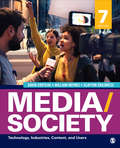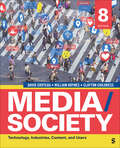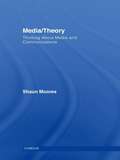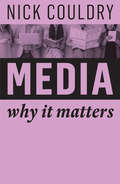- Table View
- List View
Media, Politics and Penal Reform
by Gemma BirkettThis book examines the nature of relations between penal reform campaigners, journalists and policymakers at the crime-media nexus. With a particular focus on women's penal policy, Birkett uncovers how reform strategies have augmented and developed under changing governments and the news media spotlight. While penal reformers have traditionally relied on the language of humanitarianism to influence the direction of policy, there remains an array of political and cultural sticking points. With a policy-focused orientation, this study provides a number of pragmatic and practical tips for those wishing to think more strategically about their ability to influence politicians, the media and the public. With unprecedented access to over thirty policy elites working around Westminster and Whitehall during the development of the Corston agenda (and beyond), this engaging and timely work exposes the triumphs and tribulations of such actors for the very first time.
Media, Process, and the Social Construction of Crime: Studies in Newsmaking Criminology (Current Issues in Criminal Justice #Vol. 10)
by Gregg BarakFirst published in 1995. Routledge is an imprint of Taylor & Francis, an informa company.
Media, Ritual and Identity (Communication and Society)
by James Curran Tamar LiebesMedia, Ritual and Identity examines the role of the media in society; its complex influence on democratic processes and its participation in the construction and affirmation of different social identities. It draws extensively upon cultural anthropology and combines a commanding overview of contemporary media debates with a series of fascinating case studies ranging from political ritual on television to broadcasting in the third world.
Media, Social Mobilisation and Mass Protests in Post-colonial Hong Kong: The Power of a Critical Event (Media, Culture and Social Change in Asia)
by Joseph M. Chan Francis L. LeeSince 2003, Hong Kong has witnessed a series of large-scale protests which have constituted the core of a reinvigorated pro-democracy movement. What drove tens of thousands of citizens to the street on a yearly basis to protest? What were the social and organizational bases of the protest movement? How did media and public discourses affect the protests’ formation and mobilization? How did the protesters understand their own actions and the political environment? This book tackles such questions by using a wide range of methods, including population and protest onsite surveys, media content analysis, and in-depth interviews with activists, politicians, and protest participants. It provides an account of the "self-mobilization processes" behind the historic July 1, 2003 protest, and how the protest kick-started new political dynamics and discursive contestations in the public arena which not only turned a single protest into a series of collective actions constituting a movement, but also continually shaped the movement’s characteristics and influence. The book is highly pertinent to readers interested in political development in Hong Kong, and as a case study on "the power of critical events," the book also has broad implications on the study of both media politics and social movements in general.
Media, Structures and Power
by Edward A. ComorMedia, Structures, and Power is a collection of the scholarly writing of Canada's leading communication and media studies scholar, Robert E. Babe. Spanning almost four decades of scholarship, the volume reflects the breadth of Babe's work, from media and economics to communications history and political economy.Babe famously characterized Canadian scholars' distinctive contribution to knowledge as uniquely historical, holistic, and dialectical. The essays in Media, Structures, and Power reflect this particular strength. With a clarity of vision, Babe critiques mainstream economics, Canadian government policy, and postmodernist thought in social science. Containing introductions and contributions by other prominent scholars, this volume situates Babe's work within contemporary scholarship and underscores the extent to which he is one of Canada's most prescient thinkers. His interdisciplinary analyses will remain timely and influential well into the twenty-first century.
Media, Surveillance and Affect: Narrating Feeling-States (Routledge Studies in Surveillance)
by Nicole FalkenhaynerSurveillance has become a part of everyday life: we are surrounded by surveillance technologies in news media, when we go down the street, in the movies, and even carry them in our own pockets in the form of smartphones. How are we constructing imaginaries of our realities and of ourselves as living in structures of control? What affects, emotions and feelings do we develop in societies of control, and how do we narrate them? Media, Surveillance and Affect represents a big step in revealing the depth of the entanglement of surveillance technology not only with our everyday lives, but with our imaginaries and affective experiences. Combining insights from affect studies with narratological and visual cultural studies approaches, the case studies in this book focus on how surveillance cameras and surveillance camera images have been used to narrate affective stories of Great Britain. Cases discussed include the memory work surrounding the murder of James Bulger in 1993 and of Lee Rigby in 2011, but also novels and artworks. With a multidisciplinary approach Media, Surveillance and Affect will appeal to students, scholars and specialists interested in fields such as media and cultural studies, literary studies, cultural sociology and surveillance studies.
Media, Sustainability and Everyday Life (Palgrave Studies In Media And Environmental Communication)
by Geoffrey CraigThis book analyses representations of sustainable everyday life across advertising, eco-reality television, newspapers, magazines and social media. It foregrounds the discursive and networked basis of sustainability and demonstrates how such media representations connect the home and local community to broader political, social and economic contexts. The book shows how green lifestyle media negotiate issues of sustainability in varying ways, reproducing the logic of existing consumer society while also sometimes providing projections of a more environmentally friendly existence. In this way, the book argues that everyday lifestyles are not an irredeemable problem for environmentalism but an important site of environmental politics.
Media, Telecommunications and Business Strategy
by Richard A. GershonAs the clear lines and historic boundaries that once separated broadcasting, cable, telephone and Internet communication dissolve, this comprehensive new edition examines the relationship and convergence patterns between industries by exploring the effects of digitalization in media and information technology. With today’s dynamic and rapidly evolving communication environment, media managers need to have a clear understanding of the different delivery platforms as well as critical management and planning strategies going forward. Advancements in new media and communication technology coupled with a rapidly changing global economy promise a new set of hybrid-media companies that will allow for the full integration of information and entertainment services and give new meaning to the term programming. This book provides a detailed look at seven key sectors of the media and telecommunications field as well as ongoing changes within the industry. The new edition includes updated research throughout including material on major business and technology changes as well as the importance of digital lifestyle reflected in E-commerce and developments in Over-the-Top Video-streaming services. Special attention is given to such areas as strategic planning, innovation, marketing, finance and leadership. Perfect for courses in media management and media industries, as well as professional managers, this book serves as an important reference guide during this transitional time.
Media, Telecommunications, and Business Strategy
by Richard A. GershonWith today’s dynamic and rapidly evolving environment, media managers must have a clear understanding of different delivery platforms, as well as a grasp of critical management, planning, and economic factors in order to stay current and move their organizations forward. Developed for students in telecommunications management, media management, and the business of media, this text helps future media professionals understand the relationship and convergence patterns between the broadcast, cable television, telephony, and Internet communication industries. The second edition includes updated research throughout , including material on major business and technology changes and the importance of digital lifestyle reflected in e-commerce and personalized media selection, such as Netflix and iTunes, and the growing importance of Facebook and social networking from a business perspective.
Media, Voice, Space and Power: Essays of Refraction
by Nick CouldryNick Couldry is one of the world’s leading analysts of media power and voice, and has been publishing widely for 25 years. This volume, published 20 years after The Place of Media Power, brings together a rich collection of essays from his earliest to his latest writings, some of them hard to access, plus two previously unpublished chapters. The book’s 15 chapters cover a variety of themes from voice to space, from Big Data to democracy, and from art to reality television. Taken together, they give a unique insight into the range of Couldry’s interests and passions. Throughout, Couldry’s commitment to connecting media research to wider debates in philosophy and social theory is clear. A substantial Afterword reflects on the common themes that run throughout his work and this volume, and the particular challenges of grasping media’s contribution to social order in an age of datafication. A preface by leading US media scholar Jonathan Gray sets these essays in context. The result is an exciting and clearly-written text that will interest students and researchers of media, culture and social theory across the world.
Media, War and Postmodernity
by Philip HammondMedia, War and Postmodernity investigates how conflict and international intervention have changed since the end of the Cold War, asking why Western military operations are now conducted as high-tech media spectacles, apparently more important for their propaganda value than for any strategic aims. Discussing the humanitarian interventions of the 1990s and the War on Terror, the book analyzes the rise of a postmodern sensibility in domestic and international politics, and explores how the projection of power abroad is undermined by a lack of cohesion and purpose at home. Drawing together debates from a variety of disciplinary and theoretical perspectives, Philip Hammond argues that contemporary warfare may be understood as 'postmodern' in that it is driven by the collapse of grand narratives in Western societies and constitutes an attempt to recapture a sense of purpose and meaning.
Media, War and Terrorism: Responses from the Middle East and Asia (Politics in Asia)
by Peter van der Veer Shoma MunshiThis collection of essays covers the media and public debate dimension of the events of 9/11 and beyond, from the point of view of Middle Eastern and Asian countries. The first part of the book deals with the use of the media as an instrument of warfare, the growing significance of religion, the emergence of transnational media and a transnational public sphere and the relationship between the West and the rest of the world. The second part of the book contains nine case studies relating to different parts of the Middle East and Asian world, all with a strong empirical focus, while at the same time elaborating the book's theoretical concerns.
Media, Women, and the Transformation of Sport: From Title IX to NIL
by Pamela J. Creedon Laura A. WackwitzThis edited collection provides a singular look at contemporary mediated coverage of women athletes and sports from Title IX to the present day.Through personal perspectives, contributors provide a valuable overview of common patterns in women’s sports media coverage, exploring issues of diversity, ethnicity, and inclusion. Chapters examine Title IX discourse, NIL brand creation, and marketing among female college athletes through platforms such as TikTok, Instagram, and Twitter (X), the recent surge in what appears to be empowering gender discourse and contemporary public debates, legislative attacks on the participation of trans and nonbinary athletes, differential treatment of women’s athletic injuries as compared to men’s injuries, and the role of women working in sports media both on the field and on the sidelines. The book includes a review of changes in the media coverage of women in sport, offering an overall assessment of the status of women athletes in the half-century after Title IX. It concludes with an examination of the power of coaching and the imperative to protect athletes from abuses of that power.This book will be of interest to students and scholars of media, communication, journalism, and beyond that are examining the topic of women, media, and sport.
Media,Technology and Society: A History: From the Telegraph to the Internet
by Brian WinstonChallenging the popular myth of a present-day 'information revolution', Media Technology and Society is essential reading for anyone interested in the social impact of technological change. Winston argues that the development of new media forms, from the telegraph and the telephone to computers, satellite and virtual reality, is the product of a constant play-off between social necessity and suppression: the unwritten law by which new technologies are introduced into society only insofar as their disruptive potential is limited.
Media-Mediated Relationships: Straight and Gay, Mainstream and Alternative Perspectives
by Frank Hoffmann B Lee Cooper Linda K FullerCreating a nexus between techno-science and more fundamental disciplines, a phenomenon is emerging in our personal lives: we are beginning to preempt traditional sources for relationship formation; we are becoming more insular and more cautious in starting relationships. The media play an enormous role in our activities, encouraging us to self-advertise in newspapers and magazines, to participate vicariously through pornographic and borderline books, talk radio, and tabloid television, to use our telephones and computers for the ultimate in “safe sex,” to engage in video dating, and to explore many other aspects in the field of technoeroticism.As straight and gay people alike live in a time of reluctant commitments, a period of playtime, and the Age of AIDS, the time has come to chronicle the role of mass communication in our search for interpersonal connections. Media-Mediated Relationships investigates the historical, economic, psychological, and sociocultural ramifications of the print and broadcast media, motion pictures, music, and new communications technologies (computers, video, interactive media, virtual reality, phone sex) in terms of both our individual and societal concerns. An extension of “cultivation analysis” by means of systems theory, it reports on a baseline survey of over 200 people regarding relationship mediation--demonstrating yet one more example of the symbiosis among and between various media sources.A descriptive case study, Media-Mediated Relationships provides a barometer for better understanding the many “singles” and others searching for meaning and relationships in the sociocultural milieu of the 1990s and beyond.
Media-Ready Feminism and Everyday Sexism: How US Audiences Create Meaning across Platforms (SUNY series in Feminist Criticism and Theory)
by Andrea L. Press Francesca TripodiFeminism can reflect the cultural moment, especially as media appropriate and use feminist messaging and agenda to various ends. Yet media can also push boundaries, exposing audiences to ideas they may not be familiar with and advancing public acceptance of concepts once considered taboo. Moreover, audiences are far from passive recipients, especially in the digital age. In Media-Ready Feminism and Everyday Sexism, Andrea L. Press and Francesca Tripodi focus on how audiences across platforms not only consume but also create meanings—sometimes quite transgressive meanings—in engaging with media content. If television shows such as Game of Thrones and Jersey Shore and dating apps such as Tinder are sites of persistent everyday sexism, then so, too, are they sites of what Press and Tripodi call "media-ready feminism." In developing a sociologically based conception of reception that encompasses media's progressive potential, as well as the processes of domestication through which audiences and users revert to more limited cultural schemas, Press and Tripodi make a vital contribution to gender and media studies, and help to illuminate the complexity of our current moment.
Media-State Relations and Social Media: Reimagining the Four Theories of the Press through Neo-Gramscianism
by Tyler W. WilsonThis book updates scholarship related to media-state relations for the social media age. It presents a timely account of how states have engaged with the platforms that have spread around the world – and the challenges that this presents. Further, it is positioned at a novel intersection between the Communications and International Relations disciplines, so scholars and students of both fields will find value within it.In particular, the book explores the Four Theories of the Press's role as a seminal text within media-state relations scholarship. It reimagines the original models through a Neo-Gramscian lens. The four models contained within the book deepen the analytic power of the original and align these ideas with the complexity of social media. Importantly, this book presents original research findings on measuring and quantifying the social media-state relationship as theorised by establishing and validating the new Order Index.Scholars and students of the fields discussed within will find value in the theoretical models and the quantitative instrument developed to measure these models. Of note is that the book contains the basis for using the Order Index in future research and highlights a new research future within this space.
Media/Impact: An Introduction To Mass Media (Mindtap Course List)
by Shirley BiagiFrom media history to today's rapid-fire changes, MEDIA/IMPACT: AN INTRODUCTION TO MASS MEDIA, 12th Edition takes you on a tour of the events, people, money, and technologies that have shaped the mass media industries. Known for its engaging writing style, currency, and visual appeal, the book thoroughly explores how today's mass media are converging as well as provides comprehensive coverage of the legal, ethical, social, and global issues facing the mass media industries every day. The twelfth edition focuses on convergence--how the mass media industries are intersecting to deliver content and how audiences are adapting to the new mass media marketplace. It also gives readers an insider's look at what it's like to work in each industry. In addition, it offers new coverage of digital delivery, net neutrality, media industry consolidation, social media, mobile media, and more.
Media/Society: Industries, Images, and Audiences
by David Croteau William HoynesPresenting the new edition of their undergraduate-level textbook, Croteau (sociology and anthropology, Virginia Commonwealth U.) and Hoynes (sociology, Vassar College) discuss the social components of the mass media and highlight the tension between constraint and action. Their analysis is based on a social model that sees media as being part of multidimensional process of complex interaction between audiences, technology, medial message, and media industry, all operating within the wider context of the social world. Annotation c. Book News, Inc., Portland, OR (booknews.com)
Media/Society: Technology, Industries, Content, and Users
by William Hoynes Clayton Childress David R. CroteauWinner of the 2022 Textbook & Academic Authors Association′s The McGuffey Longevity Award Media/Society: Technology, Industries, Content, and Users helps students understand the relationship between media and society and gets them to think critically about recent media developments. Authors David Croteau, William Hoynes, and new co-author Clayton Childress take an interdisciplinary approach with a sociological focus to answer questions like How do people use the media in their everyday lives? and How has the evolution of technology affected the media and how we use them? The Seventh Edition incorporates the latest scholarship and data that address enduring media topics, as well as new concerns raised by the role of digital platforms, the impact of misinformation online, and the role of media during the COVID-19 pandemic.
Media/Society: Technology, Industries, Content, and Users
by William Hoynes Clayton Childress David R. CroteauWinner of the 2022 Textbook & Academic Authors Association′s The McGuffey Longevity Award Media/Society: Technology, Industries, Content, and Users helps students understand the relationship between media and society and gets them to think critically about recent media developments. Authors David Croteau, William Hoynes, and new co-author Clayton Childress take an interdisciplinary approach with a sociological focus to answer questions like How do people use the media in their everyday lives? and How has the evolution of technology affected the media and how we use them? The Seventh Edition incorporates the latest scholarship and data that address enduring media topics, as well as new concerns raised by the role of digital platforms, the impact of misinformation online, and the role of media during the COVID-19 pandemic.
Media/Society: Technology, Industries, Content, and Users
by William Hoynes Clayton Childress David R. CroteauMedia/Society: Technology, Industries, Content, and Users provides a framework to help students understand the relationship between media and society while developing skills to critically evaluate both conventional wisdom and one’s own assumptions about the social role of media. The Eighth Edition retains its basic sociological framework but has been thoughtfully streamlined in length, while still including additional discussions of new studies and up-to-date material about a rapidly changing media landscape. With updated research, the latest industry data, and current examples from popular media, this edition helps illustrate enduring themes in the sociology of media.
Media/Society: Technology, Industries, Content, and Users
by William Hoynes Clayton Childress David R. CroteauMedia/Society: Technology, Industries, Content, and Users provides a framework to help students understand the relationship between media and society while developing skills to critically evaluate both conventional wisdom and one’s own assumptions about the social role of media. The Eighth Edition retains its basic sociological framework but has been thoughtfully streamlined in length, while still including additional discussions of new studies and up-to-date material about a rapidly changing media landscape. With updated research, the latest industry data, and current examples from popular media, this edition helps illustrate enduring themes in the sociology of media.
Media/Theory: Thinking about Media and Communications
by Shaun MooresFrom an established author with a growing international profile in media studies, Media/Theory is an accessible yet challenging guide to ways of thinking about media and communications in modern life. Shaun Moores draws on ideas from a range of disciplines in the humanities and social sciences, and expertly connects the analysis of media and communications with key themes in contemporary social theory. Examining core issues of time and space, Moores also examines matters of interactions, signification and identity, and argues that media studies is bound up in the wider processes of the modern world and not just about studying the media. This book makes a distinctive contribution towards rethinking the shape and direction of media studies today, and for students at advanced undergraduate or postgraduate level.
Media: Why It Matters (Why It Matters)
by Nick CouldryFrom TV bulletins to social media newsfeeds, the media plays a massive role in shaping the world as we see it. In fact, different media have helped make possible our world of independent nations, binding together disparate communities through shared cultural touchstones, such as the press and national broadcasters. With the transfer of people’s lives to the online world, the media has become crucial to almost every aspect of how human beings live. A new social order is being built through our relations with media, but what power over us does this give to corporations and governments? Nick Couldry explains the significance of five core dimensions of media: representing, connecting, imagining, sharing and governing. He shows that understanding these dynamics is a vital skill that every person needs in the digital age, when the fate of our political worlds and social environment may rest on how we communicate with each other.
